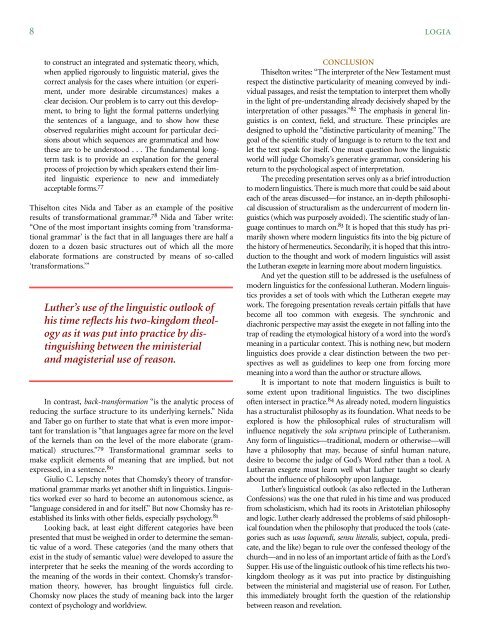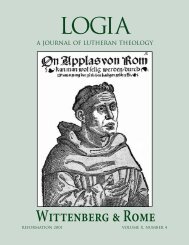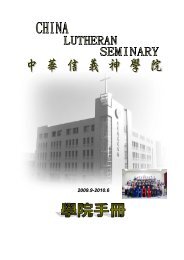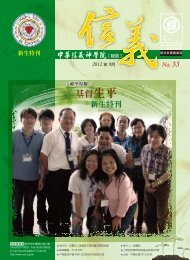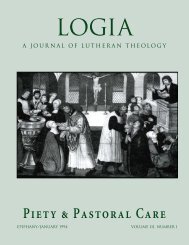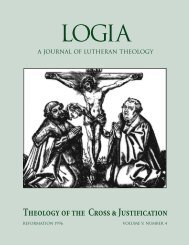04-2 Hermeneutics.pdf
04-2 Hermeneutics.pdf
04-2 Hermeneutics.pdf
- No tags were found...
You also want an ePaper? Increase the reach of your titles
YUMPU automatically turns print PDFs into web optimized ePapers that Google loves.
8 LOGIAto construct an integrated and systematic theory, which,when applied rigorously to linguistic material, gives thecorrect analysis for the cases where intuition (or experiment,under more desirable circumstances) makes aclear decision. Our problem is to carry out this development,to bring to light the formal patterns underlyingthe sentences of a language, and to show how theseobserved regularities might account for particular decisionsabout which sequences are grammatical and howthese are to be understood . . . The fundamental longtermtask is to provide an explanation for the generalprocess of projection by which speakers extend their limitedlinguistic experience to new and immediatelyacceptable forms. 77Thiselton cites Nida and Taber as an example of the positiveresults of transformational grammar. 78 Nida and Taber write:“One of the most important insights coming from ‘transformationalgrammar’ is the fact that in all languages there are half adozen to a dozen basic structures out of which all the moreelaborate formations are constructed by means of so-called‘transformations.’”Luther’s use of the linguistic outlook ofhis time reflects his two-kingdom theologyas it was put into practice by distinguishingbetween the ministerialand magisterial use of reason.nbIn contrast, back-transformation “is the analytic process ofreducing the surface structure to its underlying kernels.” Nidaand Taber go on further to state that what is even more importantfor translation is “that languages agree far more on the levelof the kernels than on the level of the more elaborate (grammatical)structures.” 79 Transformational grammar seeks tomake explicit elements of meaning that are implied, but notexpressed, in a sentence. 80Giulio C. Lepschy notes that Chomsky’s theory of transformationalgrammar marks yet another shift in linguistics. Linguisticsworked ever so hard to become an autonomous science, as“language considered in and for itself.” But now Chomsky has reestablishedits links with other fields, especially psychology. 81Looking back, at least eight different categories have beenpresented that must be weighed in order to determine the semanticvalue of a word. These categories (and the many others thatexist in the study of semantic value) were developed to assure theinterpreter that he seeks the meaning of the words according tothe meaning of the words in their context. Chomsky’s transformationtheory, however, has brought linguistics full circle.Chomsky now places the study of meaning back into the largercontext of psychology and worldview.CONCLUSIONThiselton writes: “The interpreter of the New Testament mustrespect the distinctive particularity of meaning conveyed by individualpassages, and resist the temptation to interpret them whollyin the light of pre-understanding already decisively shaped by theinterpretation of other passages.” 82 The emphasis in general linguisticsis on context, field, and structure. These principles aredesigned to uphold the “distinctive particularity of meaning.” Thegoal of the scientific study of language is to return to the text andlet the text speak for itself. One must question how the linguisticworld will judge Chomsky’s generative grammar, considering hisreturn to the psychological aspect of interpretation.The preceding presentation serves only as a brief introductionto modern linguistics. There is much more that could be said abouteach of the areas discussed—for instance, an in-depth philosophicaldiscussion of structuralism as the undercurrent of modern linguistics(which was purposely avoided). The scientific study of languagecontinues to march on. 83 It is hoped that this study has primarilyshown where modern linguistics fits into the big picture ofthe history of hermeneutics. Secondarily, it is hoped that this introductionto the thought and work of modern linguistics will assistthe Lutheran exegete in learning more about modern linguistics.And yet the question still to be addressed is the usefulness ofmodern linguistics for the confessional Lutheran. Modern linguisticsprovides a set of tools with which the Lutheran exegete maywork. The foregoing presentation reveals certain pitfalls that havebecome all too common with exegesis. The synchronic anddiachronic perspective may assist the exegete in not falling into thetrap of reading the etymological history of a word into the word’smeaning in a particular context. This is nothing new, but modernlinguistics does provide a clear distinction between the two perspectivesas well as guidelines to keep one from forcing moremeaning into a word than the author or structure allows.It is important to note that modern linguistics is built tosome extent upon traditional linguistics. The two disciplinesoften intersect in practice. 84 As already noted, modern linguisticshas a structuralist philosophy as its foundation. What needs to beexplored is how the philosophical rules of structuralism willinfluence negatively the sola scriptura principle of Lutheranism.Any form of linguistics—traditional, modern or otherwise—willhave a philosophy that may, because of sinful human nature,desire to become the judge of God’s Word rather than a tool. ALutheran exegete must learn well what Luther taught so clearlyabout the influence of philosophy upon language.Luther’s linguistical outlook (as also reflected in the LutheranConfessions) was the one that ruled in his time and was producedfrom scholasticism, which had its roots in Aristotelian philosophyand logic. Luther clearly addressed the problems of said philosophicalfoundation when the philosophy that produced the tools (categoriessuch as usus loquendi, sensu literalis, subject, copula, predicate,and the like) began to rule over the confessed theology of thechurch—and in no less of an important article of faith as the Lord’sSupper. His use of the linguistic outlook of his time reflects his twokingdomtheology as it was put into practice by distinguishingbetween the ministerial and magisterial use of reason. For Luther,this immediately brought forth the question of the relationshipbetween reason and revelation.


